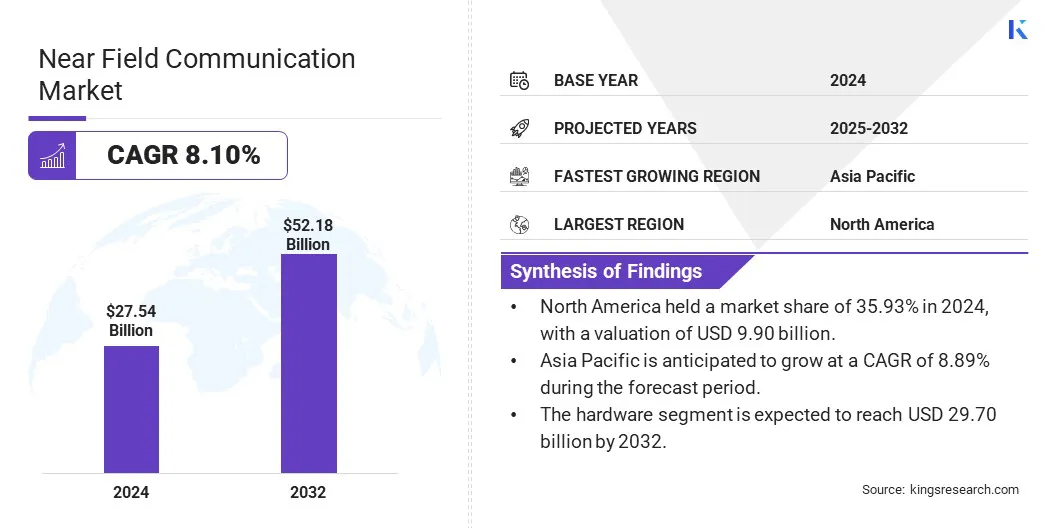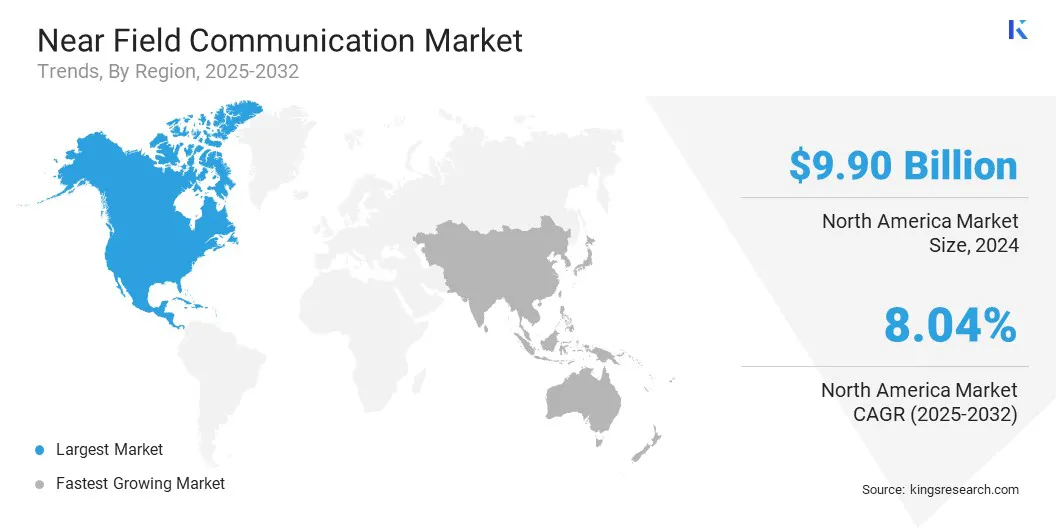Market Definition
The market includes technologies, solutions, and services that enable short-range wireless communication between compatible devices. This market includes operating modes such as reader emulation, peer-to-peer, and card emulation. Each model supports different interaction models across different devices.
It covers hardware and software components and reflects the infrastructure required for NFC-enabled operations. The report identifies the principal factors contributing to market expansion and analyzes the competitive landscape influencing its growth.
Near Field Communication Market Overview
The global near field communication market size was valued at USD 27.54 billion in 2024 and is projected to grow from USD 29.48 billion in 2025 to USD 52.18 billion by 2032, exhibiting a CAGR of 8.10% during the forecast period.
The growth is driven by the rising demand for secure and contactless payment methods. The increased adoption of NFC in smartphones and wearable devices is enabling seamless user experiences across the banking, retail, and transportation sectors.
Major companies operating in the near field communication industry are Renesas Electronics Corporation, Identiv, Inc., Infineon Technologies AG, MediaTek Inc., Texas Instruments Incorporated, AVERY DENNISON CORPORATION, NXP Semiconductors, Thales, ASSA ABLOY, Qualcomm Technologies, Inc., SONY ELECTRONICS INC., STMicroelectronics, Samsung, Broadcom, and ams-OSRAM AG.
The market is expanding with advancements in high-frequency NFC technology, which enhance data transfer speed and energy efficiency. As consumers prefer faster and more secure digital interactions, industries are actively integrating NFC into smart devices and access systems.
- In May 2024, Infineon Technologies AG launched the OPTIGA Authenticate NBT, a high-performance NFC I2C bridge tag for secure IoT authentication and configuration. The tag supports asymmetric cryptography, offers fast data exchange, and is certified as a Type 4 Tag by the NFC Forum. It provides superior security with EAL6+ certification and supports various applications, which include device configuration and smart vehicle activation.

Key Highlights:
- The global near field communication market size was valued at USD 27.54 billion in 2024.
- The market is projected to grow at a CAGR of 8.10% from 2025 to 2032.
- North America held a market share of 35.93% in 2024, with a valuation of USD 9.90 billion.
- The reader emulation segment garnered USD 11.60 billion in revenue in 2024.
- The hardware segment is expected to reach USD 29.70 billion by 2032.
- The retail segment is expected to reach USD 6.17 billion by 2032.
- Asia Pacific is anticipated to grow at a CAGR of 8.89% during the forecast period.
Market Driver
Growing Demand for Secure and Convenient Contactless Payment
The market is driven by the increasing demand for secure and convenient contactless payment solutions. Consumers and businesses are switching to faster and safer transaction methods that minimize physical contact.
This is boosting the adoption of NFC-enabled devices like smartphones and payment terminals, which allow tap-to-pay function. Enhanced security features such as encrypted data transmission and tokenization increase user trust. As a result, NFC technology is widely used across retail, banking, and transport sectors.
- In December 2024, Unified Payments Interface (UPI) processed over 16.58 billion transactions. This strengthens its role as India’s leading digital payment platform.
Market Challenge
Data Security and Privacy During Transactions
The near field communication (NFC) market faces a major challenge in ensuring data security and privacy during transactions. As the NFC technology is widely used in contactless payments, identification systems, and access controls, unauthorized access, data interception, and relay attacks remain major concerns.
A potential solution is the integration of advanced encryption protocols and secure elements within NFC-enabled devices. By embedding hardware-based security features and utilizing tokenization methods, manufacturers can strengthen data protection and enhance consumer confidence in NFC-enabled applications.
Market Trend
Advancements in high-frequency NFC technology
The market is witnessing a trend toward advancements in high-frequency NFC technology. This trend is enhancing short-range communication by enabling faster data transfer and improved energy efficiency. High-frequency NFC is well-suited for mobile payment systems, ticketing, and secure authentication.
As demand rises for seamless and secure user experiences, manufacturers are focusing on optimizing chipsets and integrating high-frequency features into consumer electronics and smart devices. This shift is expanding NFC applications across commercial and residential sectors.
- In November 2024, Identiv, Inc. announced its next-generation high-frequency (HF) NFC-enabled RFID inlays powered by NXP’s ICODE 3 chip. These inlays deliver enhanced performance, faster reading, and improved NFC features. The portfolio includes ID-Tune I3 and ID-Safe I3 NFC tags, with ID-Safe tags offering first opening indication through a conductive tamper loop.
Near Field Communication Market Report Snapshot
|
Segmentation
|
Details
|
|
By Operating Mode
|
Reader Emulation, Peer-to-Peer, Card Emulation
|
|
By Component
|
Hardware, Software
|
|
By Vertical
|
Retail, Consumer Electronics, Transportation, Hospitality, BFSI, Residential & Commercial, Healthcare, Others
|
|
By Region
|
North America: U.S., Canada, Mexico
|
|
Europe: France, UK, Spain, Germany, Italy, Russia, Rest of Europe
|
|
Asia-Pacific: China, Japan, India, Australia, ASEAN, South Korea, Rest of Asia-Pacific
|
|
Middle East & Africa: Turkey, U.A.E., Saudi Arabia, South Africa, Rest of Middle East & Africa
|
|
South America: Brazil, Argentina, Rest of South America
|
Market Segmentation:
- By Operating Mode (Reader Emulation, Peer-to-Peer and Card Emulation): The reader emulation segment earned USD 11.60 billion in 2024, owing to its widespread use in contactless payments and secure access control systems.
- By Component (Hardware and Software): The hardware segment held 57.63% of the market in 2024, due to the growing adoption of NFC-enabled smartphones, POS terminals, and access control devices.
- By Vertical (Retail, Consumer Electronics, Transportation, Hospitality, BFSI, Residential & Commercial, Healthcare, Others): The retail segment is projected to reach USD 11.64 billion by 2032, on account of the rising demand for contactless payment solutions and improved customer experience.
Near Field Communication Market Regional Analysis
Based on region, the global market has been classified into North America, Europe, Asia Pacific, Middle East & Africa, and South America.

The North America near field communication market share stood at around 35.93% in 2024 in the global market, with a valuation of USD 9.90 billion. This dominance is driven by high smartphone adoption, popularity of contactless payment systems, and the presence of leading technology firms.
The region benefits from well-established digital infrastructure and a mature retail ecosystem that actively integrates NFC for improved customer engagement and transaction efficiency. Regulatory support for secure digital payments has further contributed to widespread deployment across sectors.
- In October 2023, Carrier introduced the NFC technology in its redesigned gas furnace lineup. This allows dealers to modify settings and access diagnostic information using a phone, even without power or cell service. Incorporated into the Carrier Service Tech App, it offers quality verifications, troubleshooting tips, saved features for repeat installations, and report exports while improving efficiency for dealers and technicians.
The Asia Pacific near field communication industry is poised to grow at a significant rate, with a CAGR of 8.89% over the forecast period. The growth is driven by rapid urbanization, expanding mobile user base, and the rise in adoption of digital wallets.
Governments in countries such as China, India, and Japan are promoting cashless economies, accelerating the use of NFC in public transport, banking, and retail. Increasing investments in smart city initiatives and rising demand for contactless solutions are expected to drive growth in the region.
Regulatory Frameworks
- In the U.S, near field communication (NFC) systems are regulated under the Federal Communications Commission (FCC) Part 15 rules, which govern unlicensed radio frequency devices to ensure that they do not cause harmful interference.
- In Europe, NFC technology falls under the Radio Equipment Directive (RED) 2014/53/EU, which mandates that all wireless communication devices, including those using NFC, meet essential requirements related to health, safety, electromagnetic compatibility, and efficient use of the radio spectrum.
Competitive Landscape
Key players in the near field communication market are focusing on integrating NFC into smartphones, wearables, and smart cards to increase functionality across verticals. Companies are investing in research and development to enhance chip performance, improve security protocols, and reduce power consumption.
Many firms are partnering with telecom operators, financial institutions, and mobility service providers to expand their solutions' reach. Other participants in the market are also entering into licensing agreements to gain access to patented technologies and accelerate time to market.
To strengthen regional footprints, companies are setting up local manufacturing units and customizing offerings based on regulatory and consumer requirements. Strategic acquisitions are being used to diversify product portfolios and strengthen positions in contactless payment and identification applications.
- In August 2024, Apple announced that with iOS 18.1, developers can offer in-app NFC contactless transactions using the Secure Element. This allows secure payments, digital keys, transit passes, IDs, and loyalty cards within apps, separate from Apple Pay. Developers must enter a commercial agreement with Apple and meet security and regulatory requirements to access the NFC and SE APIs.
List of Key Companies in Near Field Communication Market:
- Renesas Electronics Corporation
- Identiv, Inc.
- Infineon Technologies AG
- MediaTek Inc.
- Texas Instruments Incorporated
- AVERY DENNISON CORPORATION
- NXP Semiconductors
- Thales
- ASSA ABLOY
- Qualcomm Technologies, Inc.
- SONY ELECTRONICS INC.
- STMicroelectronics
- Samsung
- Broadcom
- ams-OSRAM AG
Recent Developments (Product Launch)
- In March 2025, Pragmatic Semiconductor launched its Pragmatic NFC Connect product line. It features flexible and ultra-thin NFC chips with a low carbon footprint. Powered by FlexIC technology, these chips enable seamless NFC integration on curved surfaces and support iOS/Android and NFC Forum Type-V compatibility.
- In July 2024, Paytm launched India’s first NFC Card Soundbox, a dual mobile QR and NFC card payment device, designed to offer affordable and secure payments for millions of offline merchants.
- In January 2024, Advanced Card Systems Ltd (ACS) launched the ACR1552 Series, which featured three next-generation NFC readers for enhancing secure transactions and identification across finance, healthcare, and government sectors.


